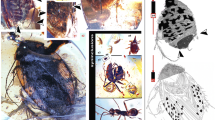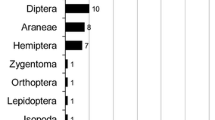Abstract
The paleotropical tree genusMacaranga (Euphorbiaceae) comprises all stages of interaction with ants, from facultative associations to obligate myrmecophytes. In SE.-Asia food availability does not seem to be the limiting factor for the development of a close relationship since all species provide food for ants in form of extrafloral nectar and/or food bodies. Only myrmecophyticMacaranga species offer nesting space for ants (domatia) inside internodes which become hollow due to degeneration of the pith. Non-myrmecophytic species have a solid stem with a compact and wet pith and many resin ducts. The stem interior of some transitional species remains solid, but the soft pith can be excavated. The role of different ant-attracting attributes for the development of obligate ant-plant interactions is discussed. In the genusMacaranga, the provision of nesting space seems to be the most important factor for the evolution of obligate myrmecophytism.
Similar content being viewed by others
References
Agosti, D., 1991: Revision of the oriental ant genusCladomyrma, with an outline of the higher classification of theFormicinae (Hymenoptera: Formicidae). — Syst. Entomol.16: 293–310.
Beattie, A. J., 1985: The evolutionary ecology of ant-plant mutualisms. — Cambridge: Cambridge University Press.
Bequaert, J., 1922: Ants in their diverse relations to the plant world. — Bull. Amer. Mus. Nat. Hist.45: 333–621.
Berg, C. C., 1981: An exceptional new species ofCecropia (Moraceae) from Ecuador. — Nordic J. Bot.1: 485–487.
Buckley, R. C., (Ed.), 1982: Ant-plant interactions in Australia. — The Hague: W. Junk.
Davidson, D. W., 1991: Ant-plant symbioses: framing the questions. — InHuxley, C. R., Cutler, D. F., (Eds.): Interactions between ants and plants, pp. 289–304. — Oxford: Oxford University Press.
Fiala, B., Maschwitz, U., 1990: Studies on the South East Asian ant-plant associationCrematogaster borneensis/Macaranga: Adaptations of the ant partner. — Ins. Soc.37: 212–231.
—, —, 1990: Extrafloral nectaries in the genusMacaranga (Euphorbiaceae) in Malaysia: comparative studies of their possible significance as predispositions for myrmecophytism. — Biol. J. Linn. Soc.44: 287–305.
- - 1992: Food bodies and their significance for obligate ant-association in the tree genusMacaranga (Euphorbiaceae). — Bot. J. Linn. Soc. (in press).
—, —,Tho, Y. P., 1991: The association betweenMacaranga and ants in South East Asia. — InHuxley, C. R., Cutler, D. F., (Eds.): Interactions between ants and plants, pp. 263–270. — Oxford: Oxford University Press.
—, —, —,Helbig, A. J., 1989: Studies of a South East Asian ant-plant association: protection ofMacaranga trees byCrematogaster borneensis. — Oecologia (Berlin)79: 463–470.
Hölldobler, B., Wilson, E. O., 1990: The ants. — Cambridge, Mass.: Belknap University Press.
Huxley, C. R., 1986: Evolution of benevolent ant-plant relationships. — InJuniper, B., Southwood, R., (Eds.): Insects and the plant surface, pp. 257–282. — London: E. Arnold.
Jolivet, P., 1986: Les fourmis et les plantes. — Paris: Singer-Polignac.
Keeler, K. H., 1989: Ant-plant interactions. — InAbrahamson, W. G., (Ed.): Plantanimal interactions, pp. 207–242. — New York: MacGraw-Hill.
Lundstroem, A. N., 1887: Die Anpassungen der Pflanzen an die Tiere. — Uppsala.
Maschwitz, U., Dumpert, K., Schmidt, G., 1985: Silk pavilions of twoCamponotus (Karavaievia) species from Malaysia: description of a new nesting type in ants. — Z. Tierpsychol.69: 237–249.
—,Fiala, B., Lee, Y. F., Chey, Y. K., Tan, F. L., 1989: New and little known myrmecophytic associations from Bornean rainforests. — Malaysian Nat. J.43: 106–115.
—,Dumpert, K., Botz, T., Rohe, W., 1991a: A silk-nest weaving Dolichoderine ant in a Malayan rain forest. — Ins. Soc.38: 307–316.
—,Fiala, B., Moog, J., Saw, L. G., 1991b: Two new myrmecophytic associations from the Malay Peninsula: ants of the genusCladomyrma (Formicidae, Camponotinae) as partners ofSaraca thaipingensis (Caesalpiniaceae) andCrypteronia griffithii (Crypteroniaceae). — Ins. Soc.38: 27–35.
McKey, D., 1989: Interactions between ants and leguminous plants. — InStirton, C. H., Zarucchi, J. L., (Eds.): Advances in legume biology, pp. 673–718. — Monogr. Syst. Bot. 29. — St. Louis: Missouri Botanical Garden.
Schaeffer, J., 1971: A revision of the genusEndospermum Bth. (Euphorbiaceae). — Blumea19: 171–192.
Ward, P. S., 1991: Phylogenetic analysis of pseudomyrmecine ants associated with domatiabearing plants. — InHuxley, C. R., Cutler, D. F., (Eds.): Interactions between ants and plants, pp. 335–352. — Oxford: Oxford University Press.
Wheeler, W. M., 1942: Studies of neotropical ant-plants and their ants. — Bull. Amer. Mus. Comp. Zool. Harvard90: 1–251.
Whitmore, T. C., 1967: Studies inMacaranga, an easy genus of Malayan wayside trees. — Malaysian Nat. J.20: 89–99.
—, 1969: First thoughts on species evolution in MalayanMacaranga. — Biol. J. Linn. Soc.1: 223–231.
—, 1973: Tree flora of Malaya. — Kuala Lumpur, London: Longman.
—, 1975:Macaranga. — InAiry-Shaw, H. K., (Ed.): TheEuphorbiaceae of Borneo. — Kew Bull. Add. Ser.4: 140–159.
—, 1979: Studies inMacaranga, X. Potentially commercial species in New Guinea. — Commenw. For. Rev.58: 271–272.
—, 1982:Macaranga. — InAiry-Shaw, H. K., (Ed.): TheEuphorbiaceae of Sumatra. — Kew Bull.36: 312–323.
Wilson, E. O., 1959: Some ecological characteristics of ants in New Guinea rainforests. — Ecology40: 437–447.
—, 1987: The arboreal ant fauna of Peruvian Amazon forests: a first assessment. — Biotropica19: 245–251.
Author information
Authors and Affiliations
Rights and permissions
About this article
Cite this article
Fiala, B., Maschwitz, U. Domatia as most important adaptations in the evolution of myrmecophytes in the paleotropical tree genusMacaranga (Euphorbiaceae). Pl Syst Evol 180, 53–64 (1992). https://doi.org/10.1007/BF00940397
Received:
Revised:
Accepted:
Issue Date:
DOI: https://doi.org/10.1007/BF00940397




